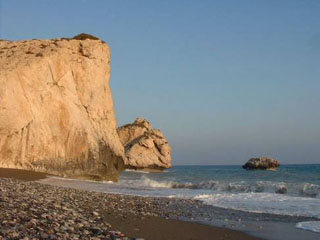| |
Many
of the great Greek poets, such as Homer (c.750BC) and Hesiod (c.7th
century BC?), associate Aphrodite, the Greek goddess of love, fruitfulness
and beauty with the island of Cyprus. The connection is mentioned not
only in second "Homeric Hymn" to Aphrodite, but also in Homer's
Illiad and Odyssey.
Hesiod describes the wonderful birth of the goddess from the foam of
the sea and her emergence onto dry land on the island. The Cypriot tradition
is that she came ashore near the magnificent 'Petra tôu Romiou',
the 'Rock of the Greek'.
|
 |
| |
Petra
tôu Romiou, "Rock of the Greek" |
| |
|
| |
Homer,
however, tells a different story of the origins of Aphrodite. He says,
in the Illiad, that she is the daughter
of the goddess Dione and the god Zeus. The ‘Homeric Hymn’ to
Aphrodite describes a sanctuary at Paphos and how the goddess used it: |
| |
|
| |
‘She went to Cyprus, to Paphos,
where her precinct is and fragrant altar, and passed into her sweet-smelling
temple. There she went in and put to the glittering doors, and there
the Graces bathed her with heavenly oil such as blooms upon the bodies
of the eternal gods – oil divinely sweet, which she had by her,
filled with fragrance. And laughter-loving Aphrodite put on all her
rich clothes, and when she had decked herself with gold, she left
sweet-smelling Cyprus….’
(Second Homeric Hymn To Aphrodite)
|
| |
|



